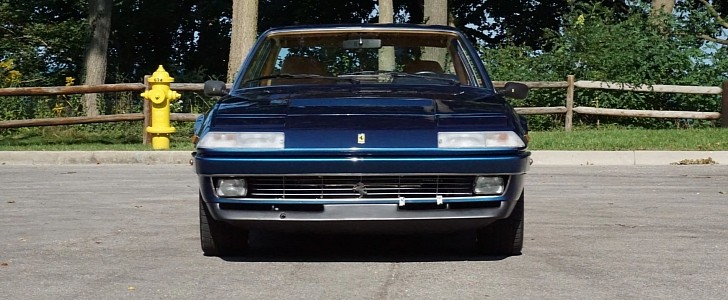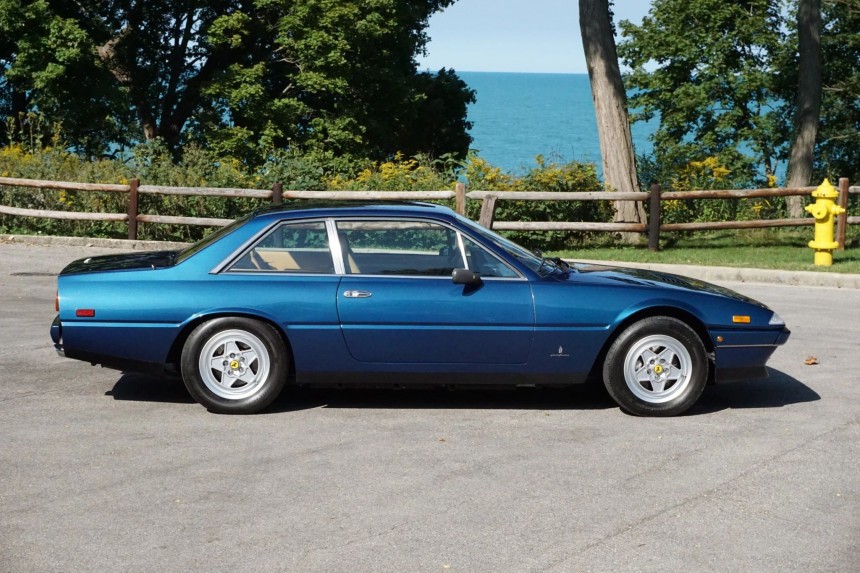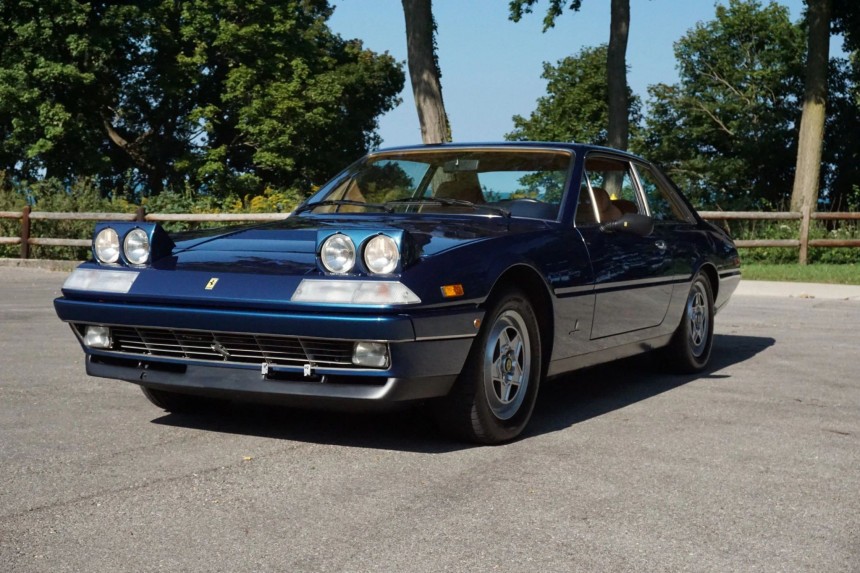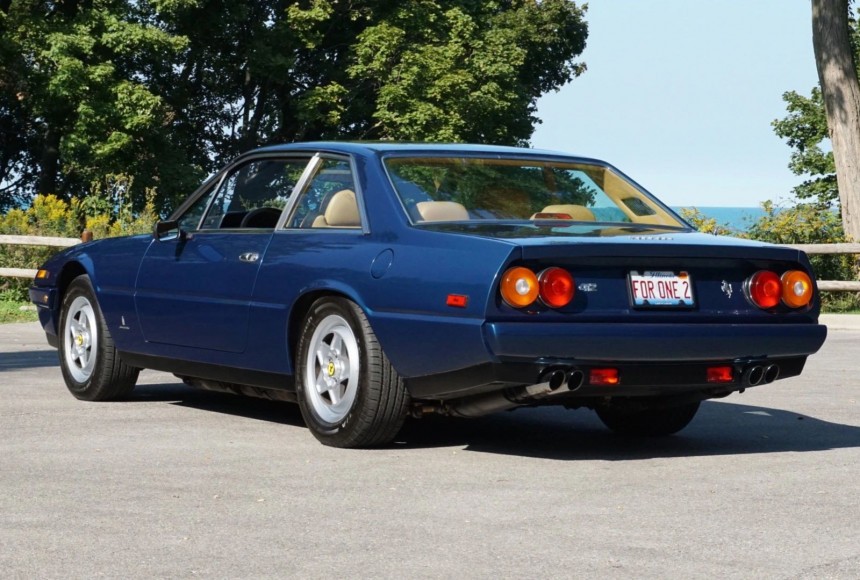Not exactly the prettiest grand tourer out there, the 412 marked the bitter end to Ferrari’s longest-running series of road-going cars. Styled by Leonardo Fioravanti and bodied by Turinese coachbuilder Pininfarina, the 365 GT4 2+2 rolled out in 1972 as the replacement for the 365 GTC/4.
365 is an estimate of each cylinder’s displacement in cubic centimeters, GT4 actually refers to four camshafts, and 2+2 is pretty much self-explanatory. The Prancing Horse of Maranello updated this fellow in 1976 with minor styling changes and a slightly larger engine (4.9 rather than 4.8 liters).
The 400 is the Italian automaker’s first production vehicle to be offered with a torque-converter automatic transmission. The subsequent 400i we’ve covered only recently on autoevolution features the “i” suffix to designate its mechanical fuel-injection system, also a first for Ferrari.
Replaced by the superb-looking 456 in 1992, the 412 is the ultimate incarnation of the F101 series. Produced between 1985 (the year that saw the debut of Calvin and Hobbes) and 1989 (the year of the Tiananmen Square protests and massacre), the Four-Twelve features an even larger engine than its predecessor. Bored 1 millimeter for an increase in displacement from 4,823 to 4,942 cubic centimeters, the F101 E is the final evolution of the Colombo V12, named after Gioachino Colombo, the guy who developed the automaker’s first homegrown powerplant. Its first application was the 1.5-liter mill in the 125 S sports racer from 1947.
An all-alloy setup with two valves per cylinder, the 4.9-liter engine is rocking wet-sump lubrication, a 9.6:1 compression ratio, Marelli Microplex electronic ignition, and two transmission choices. Manual-equipped lumps are codenamed F101 E 010, whereas F101 E 70 is used for the BorgWarner-supplied yet General Motors-designed automatic. More specifically, the two-pedal option is the long-running TH400 introduced back in 1964.
As for suck-squeeze-bang-blow shenanigans, Ferrari quoted 340 metric ponies (335 horsepower) at 6,000 revolutions per minute and 451 Nm (333 pound-foot) of torque at 4,200 revolutions per minute. Not bad for that era, more so when compared to the 315 ps (311 hp) and 412 Nm (304 lb-ft) of torque produced by the preceding model. Lighter by 20 to 25 kilograms (44 to 55 pounds) compared to its predecessor, the 412 could reach 245 kph (152 mph) with the auto or 250 kph (155 mph) with the manual box.
Ferrari also promised 8.3 or 6.7 seconds to 100 kph (62 mph). The 400-meter run (a quarter mile has 402 meters) was dealt with in 15.2 and 14.6 seconds, respectively. As mentioned beforehand, not bad for the mid-1980s, especially when you remember how old the car’s underpinnings were.
Presented at the 1985 Geneva Motor Show, the 412 can be perfectly summed up as a discretely elegant cruiser with seating for four souls. Based on a tubular steel chassis with a wheelbase that stretches 2,700 millimeters (106.3 inches) between the front and rear axles, the three-box Fezza we’re covering today is equipped with unequal-length wishbones all around.
Coil springs and telescopic shock absorbers from Koni are fitted at either end, along with anti-roll bars for good measure. The rear axle is a self-leveling unit, and customary of a high-end gran turismo from the ‘80s, power steering was standard. The first-ever production Ferrari to be fitted with anti-lock brakes originally sported Michelin TRX rubber boots wrapped around five-spoke alloy wheels. Although it looks extremely similar to the 400i before it, the 412 features a slightly wider front track.
The naturally-aspirated V12 up front is fed by a couple of fuel tanks with a combined capacity of 120 liters (31.7 U.S. gallons or 26.4 imperial gallons). Pininfarina’s facility in Turin produced the steel body shell, which was then joined with the aluminum trunk lid and hood at the Maranello factory.
Body-color bumpers were standard, and clear rather than amber indicator lenses were fitted. Satin-black touches here and there also need to be mentioned, along with a quad exhaust, larger side mirrors, black window trim instead of chrome, and two Pininfarina badges on the front fenders.
Dual pop-up headlights and dual taillights, all of them round, bring the point home. A car that you might recognize from Daft Punk’s Electroma, the 412 flaunts a Momo steering wheel and a steering column housing cover that reads Ferrari, 412, and vehicle identification number. Black gauges with orange numbers and letters, air conditioning, leather upholstery, electric windows, electric front seats, and central locking are featured as well.
Pretty spacious for a 2+2 grand tourer, the 412 can swallow up to 500 liters (17.6 cubic feet) of whatnots in the trunk. The Mercedes-Benz V177 A-Class Sedan, which is a compact with a similar wheelbase to this Ferrari, has 405 liters (14.3 cubic feet) with the seats in their normal position.
Optional extras included the automatic we’ve touched upon earlier, fitted luggage from Schedoni, dual-zone air conditioning, and the oh-so-important sunroof. A grand total of 576 units were completed by late 1989, split between 270 manuals and 306 automatics. Of those, 24 manuals and 61 automatics were finished in wrong-hand drive, a.k.a. right-hand drive in the UK, the Oz, and other regions where driving on the left is the norm.
The 400 is the Italian automaker’s first production vehicle to be offered with a torque-converter automatic transmission. The subsequent 400i we’ve covered only recently on autoevolution features the “i” suffix to designate its mechanical fuel-injection system, also a first for Ferrari.
Replaced by the superb-looking 456 in 1992, the 412 is the ultimate incarnation of the F101 series. Produced between 1985 (the year that saw the debut of Calvin and Hobbes) and 1989 (the year of the Tiananmen Square protests and massacre), the Four-Twelve features an even larger engine than its predecessor. Bored 1 millimeter for an increase in displacement from 4,823 to 4,942 cubic centimeters, the F101 E is the final evolution of the Colombo V12, named after Gioachino Colombo, the guy who developed the automaker’s first homegrown powerplant. Its first application was the 1.5-liter mill in the 125 S sports racer from 1947.
As for suck-squeeze-bang-blow shenanigans, Ferrari quoted 340 metric ponies (335 horsepower) at 6,000 revolutions per minute and 451 Nm (333 pound-foot) of torque at 4,200 revolutions per minute. Not bad for that era, more so when compared to the 315 ps (311 hp) and 412 Nm (304 lb-ft) of torque produced by the preceding model. Lighter by 20 to 25 kilograms (44 to 55 pounds) compared to its predecessor, the 412 could reach 245 kph (152 mph) with the auto or 250 kph (155 mph) with the manual box.
Ferrari also promised 8.3 or 6.7 seconds to 100 kph (62 mph). The 400-meter run (a quarter mile has 402 meters) was dealt with in 15.2 and 14.6 seconds, respectively. As mentioned beforehand, not bad for the mid-1980s, especially when you remember how old the car’s underpinnings were.
Coil springs and telescopic shock absorbers from Koni are fitted at either end, along with anti-roll bars for good measure. The rear axle is a self-leveling unit, and customary of a high-end gran turismo from the ‘80s, power steering was standard. The first-ever production Ferrari to be fitted with anti-lock brakes originally sported Michelin TRX rubber boots wrapped around five-spoke alloy wheels. Although it looks extremely similar to the 400i before it, the 412 features a slightly wider front track.
The naturally-aspirated V12 up front is fed by a couple of fuel tanks with a combined capacity of 120 liters (31.7 U.S. gallons or 26.4 imperial gallons). Pininfarina’s facility in Turin produced the steel body shell, which was then joined with the aluminum trunk lid and hood at the Maranello factory.
Dual pop-up headlights and dual taillights, all of them round, bring the point home. A car that you might recognize from Daft Punk’s Electroma, the 412 flaunts a Momo steering wheel and a steering column housing cover that reads Ferrari, 412, and vehicle identification number. Black gauges with orange numbers and letters, air conditioning, leather upholstery, electric windows, electric front seats, and central locking are featured as well.
Pretty spacious for a 2+2 grand tourer, the 412 can swallow up to 500 liters (17.6 cubic feet) of whatnots in the trunk. The Mercedes-Benz V177 A-Class Sedan, which is a compact with a similar wheelbase to this Ferrari, has 405 liters (14.3 cubic feet) with the seats in their normal position.
Optional extras included the automatic we’ve touched upon earlier, fitted luggage from Schedoni, dual-zone air conditioning, and the oh-so-important sunroof. A grand total of 576 units were completed by late 1989, split between 270 manuals and 306 automatics. Of those, 24 manuals and 61 automatics were finished in wrong-hand drive, a.k.a. right-hand drive in the UK, the Oz, and other regions where driving on the left is the norm.




































































